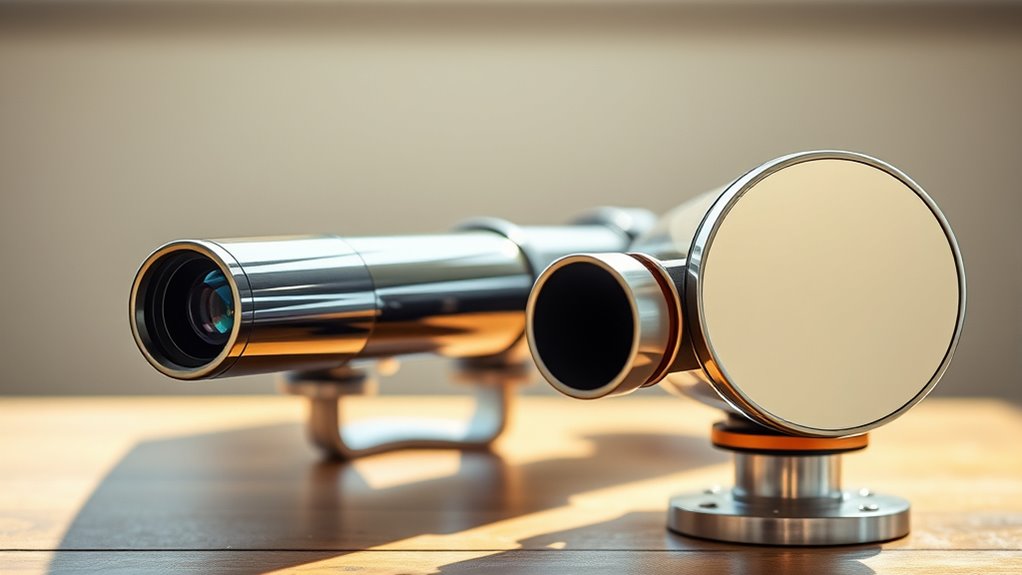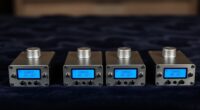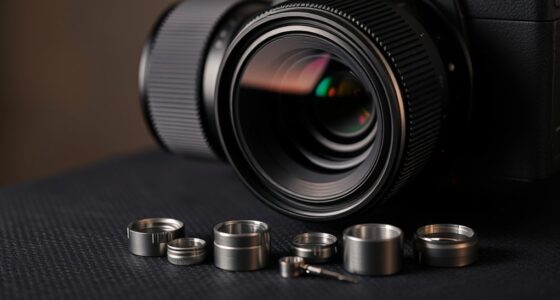If you’re a beginner choosing between a refractor and a reflector telescope, consider their pros and cons. Refractors are easier to use, more durable, and ideal for details on planets and the Moon. Reflectors offer larger apertures at lower prices, great for deep-sky objects but may need more maintenance and adjustment. Knowing their differences helps you pick the best one for your budget and goals—if you want more details, keep exploring the options.
Key Takeaways
- Refractors are easier to set up, maintain, and portable, making them ideal for beginners.
- Reflectors offer larger apertures at lower costs, great for deep-sky object viewing.
- Refractors produce sharper, high-contrast images suitable for planetary and lunar observation.
- Reflectors may require more adjustments and care but provide brighter images for wide-field astronomy.
- Overall, refractors are better for simple, quick use; reflectors are better for budget-friendly, deep-sky exploration.
What Are Refractor and Reflector Telescopes?
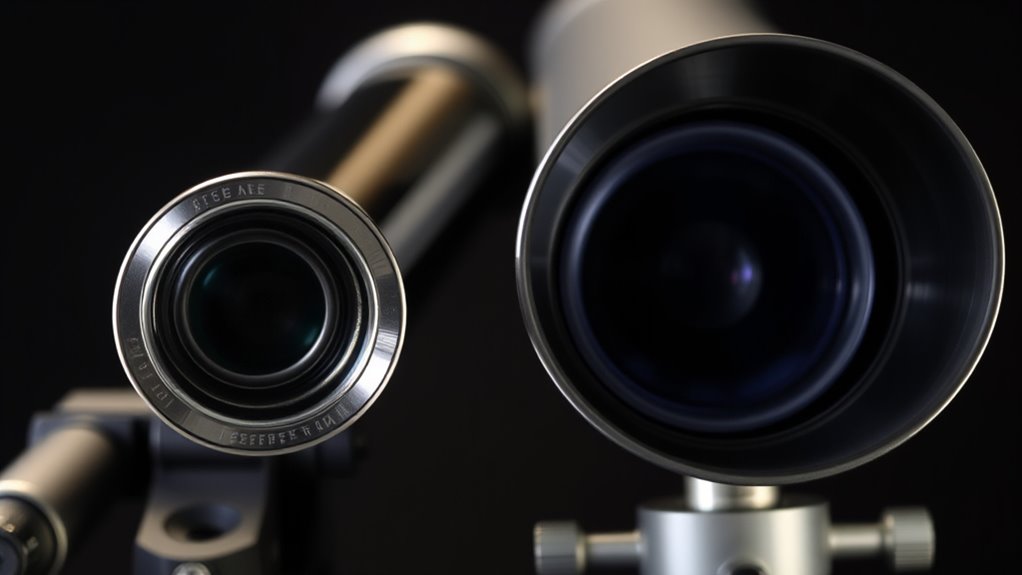
Refractor and reflector telescopes are two main types of telescopes used for astronomical observation. Refractors use a simple optical design with lenses to gather and focus light, making them reliable and easy to maintain. Reflectors, on the other hand, use mirrors to collect light, which allows for larger apertures at a lower cost. If you’re a beginner, your preferences might influence your choice: refractors often appeal for their straightforward setup and crisp images, while reflectors can provide more power for less money. The optical design of each type impacts image clarity, size, and maintenance needs. Understanding these differences helps you decide which telescope suits your interests and budget, setting a solid foundation for your stargazing adventures. Additionally, considering the construction and design can help you evaluate the durability and ease of use of your chosen telescope.
Ease of Use for Beginners
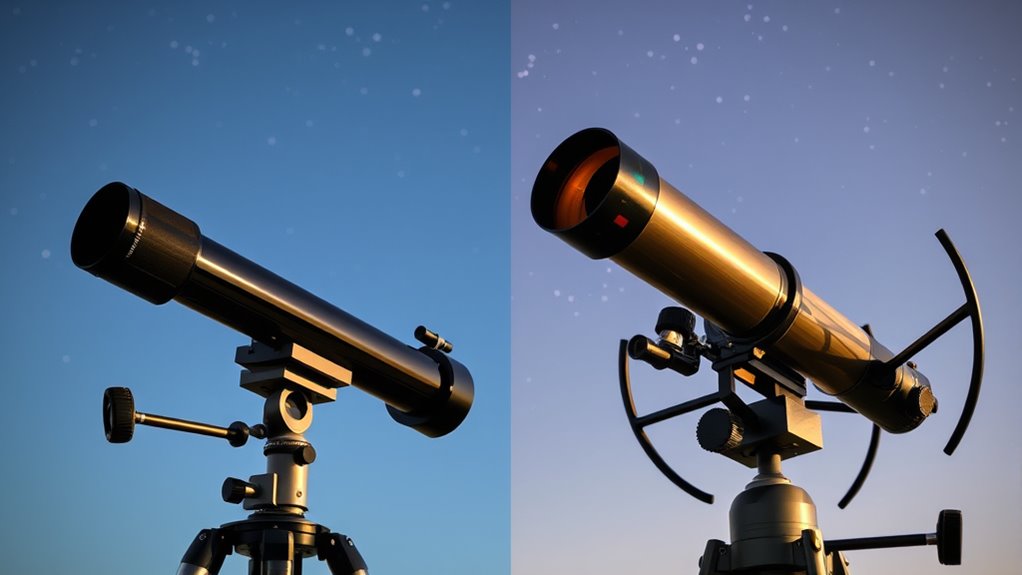
As a beginner, you’ll find that some telescopes are easier to set up and operate than others. Refractors typically require less maintenance and are more straightforward to assemble, making them a good first choice. Reflectors may need more adjustments over time, which can be a bit more challenging if you’re just starting out. Additionally, understanding optical technology can help you make more informed decisions about which type suits your needs best.
Setup Simplicity
When it comes to setup simplicity, refractors are generally easier for beginners to handle. They usually come with straightforward mounting options, often a single, stable tripod that’s quick to assemble. This makes setting up quick and hassle-free, especially if you’re new to astronomy. Refractors also tend to have better eyepiece compatibility, meaning you can easily swap different eyepieces without fuss. Reflectors, on the other hand, often require more steps to assemble due to their larger, more complex mounts and sometimes need collimation before use. Overall, refractors are more user-friendly for beginners because you spend less time setting up and more time observing. Their design simplifies the process, making your first stargazing experiences smoother and more enjoyable. Additionally, the optical design of refractors generally results in less maintenance and alignment compared to reflectors.
Maintenance Ease
Maintaining a telescope can be straightforward or complex, depending on its design. Refractors generally have a simpler cleaning routine because their lenses are sealed, protecting them from dust and moisture. This makes regular maintenance easier for beginners. Reflectors, on the other hand, require more careful cleaning of mirrors and occasional realignment, which can be more involved. Repair complexity also varies: refractors tend to be more durable with fewer parts to service, while reflectors might need adjustments or mirror recoating over time. If you prefer a low-maintenance setup, a refractor might be the better choice. However, if you’re willing to learn some basic cleaning and repair techniques, a reflector can still be manageable. Overall, your experience with maintenance depends on your willingness to learn and perform routine care. Understanding industry trends can also help you anticipate potential issues and extend the lifespan of your telescope.
Image Quality and Clarity
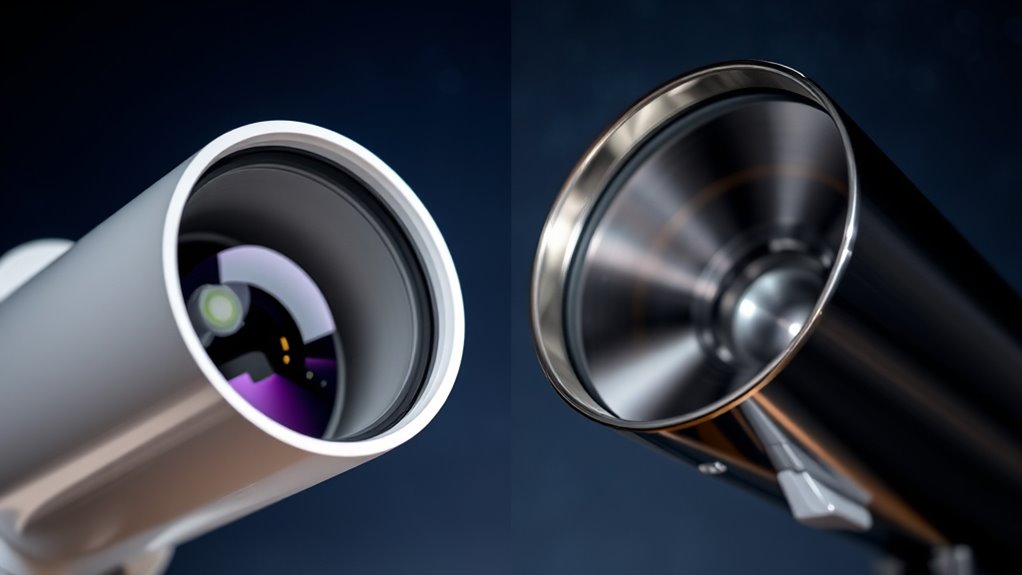
You’ll notice that refractors often deliver sharper images with more detail, making crisper views of planets and the moon. Reflectors can produce brighter images with higher contrast, especially for faint deep-sky objects. Considering these differences helps you choose a telescope that matches your preferences for image clarity and quality.
Image Sharpness and Detail
Image sharpness and detail are crucial factors when choosing between a refractor and a reflector telescope, as they directly impact the clarity of what you observe. Refractors often provide crisper images thanks to high-quality lens coatings that reduce glare and enhance contrast, boosting overall image resolution. Reflectors, on the other hand, can sometimes produce slightly less sharp images because of mirror alignment issues or secondary mirror effects. However, quality reflectors with well-aligned mirrors can still deliver impressive detail. Your choice depends on how much sharpness matters for your observing goals. Proper lens coatings in refractors can make a significant difference in image clarity, ensuring you see fine details, especially when observing planets or lunar features. Additionally, maintaining proper mirror alignment in reflectors is essential for achieving optimal image sharpness.
Brightness and Contrast
Brightness and contrast play an essential role in how clearly you see celestial objects through your telescope. A larger aperture size gathers more light, enhancing brightness and contrast, making faint objects easier to observe. Reflectors typically have bigger apertures for the same price, increasing light gathering power. This results in brighter images and better contrast, especially for dim objects. Refractors often have smaller apertures but deliver crisp images with high contrast, ideal for planets and bright stars. Use the table below to compare:
| Aspect | Refractor | Reflector | Best For |
|---|---|---|---|
| Aperture Size | Smaller, but high-quality | Larger, more light gathering | Deep-sky objects |
| Light Gathering | Less, limited by size | More, better brightness | Faint objects |
| Image Brightness | Clear but dimmer | Brighter, more vivid | Low-light conditions |
| Contrast | High, sharp images | Good, but depends on design | Detail-rich observations |
Additionally, the design differences between refractors and reflectors can influence their image quality and maintenance needs.
Cost Differences Between the Two Types
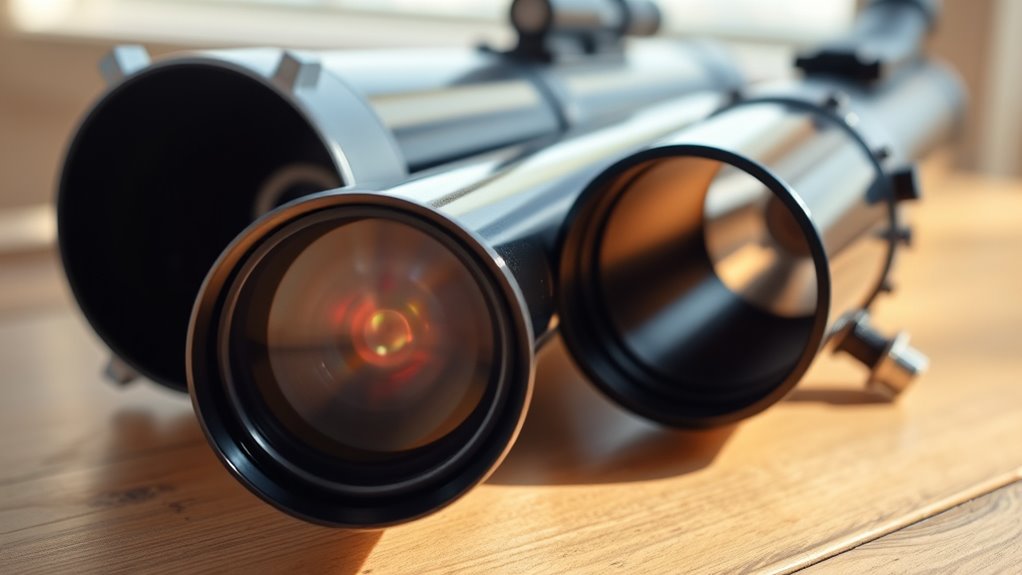
Refractor telescopes generally cost more upfront than their reflector counterparts, mainly due to their high-quality lenses and precise construction. If you’re on a tight budget, you might find better options with reflectors, which are typically cheaper initially. However, consider long-term costs—refractors often require less maintenance and fewer upgrades over time, which can save you money in the long run. Reflectors can be more affordable at the start but may need regular collimation and occasional repairs, adding to ongoing expenses. If you’re just starting out and want a budget option, reflectors provide good value, but if you prioritize durability and lower maintenance costs, a refractor might be worth the extra initial investment. Ultimately, your choice depends on your budget and future expectations. Grocery savings strategies can also help you allocate more funds toward quality equipment like telescopes.
Maintenance and Durability
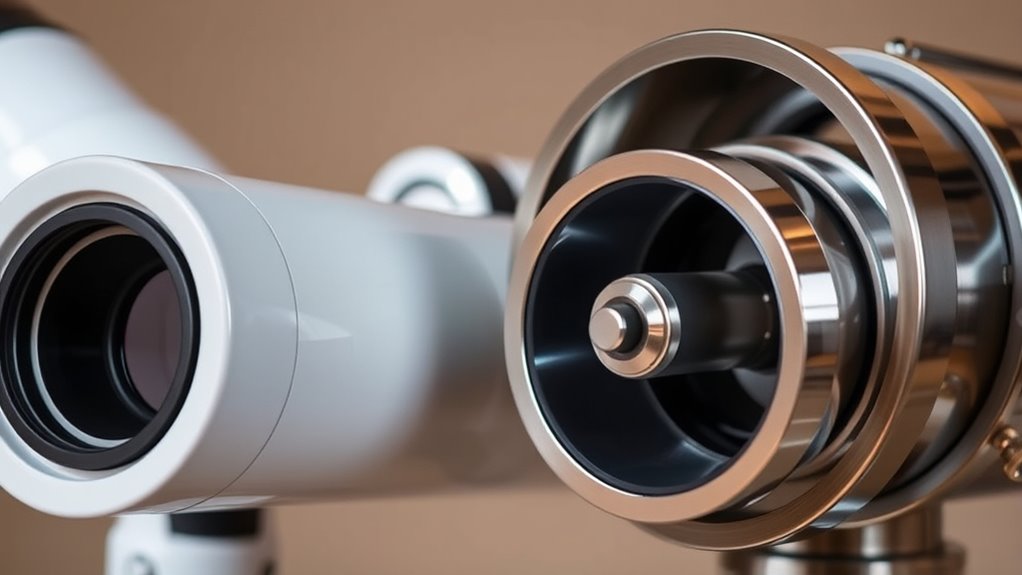
Refractors are known for their durability and low-maintenance requirements, making them a reliable choice for many observers. Their sealed optical tube minimizes dust and debris, reducing the need for frequent cleaning. You won’t have to worry much about lens alignment, as refractors generally hold their alignment well over time. Additionally, their coatings are designed to be durable, resisting scratches and deterioration that can affect image quality. Regularly wiping the lens with a proper cloth keeps the coatings intact, ensuring clear views for years. Unlike some telescopes that require frequent collimation, refractors stay aligned longer, saving you time and effort. Overall, their sturdy design and resilient coatings make refractors a convenient, long-lasting option for beginners seeking minimal upkeep. Furthermore, their resistance to environmental factors enhances their durability, making them suitable for various observing conditions.
Size, Weight, and Portability
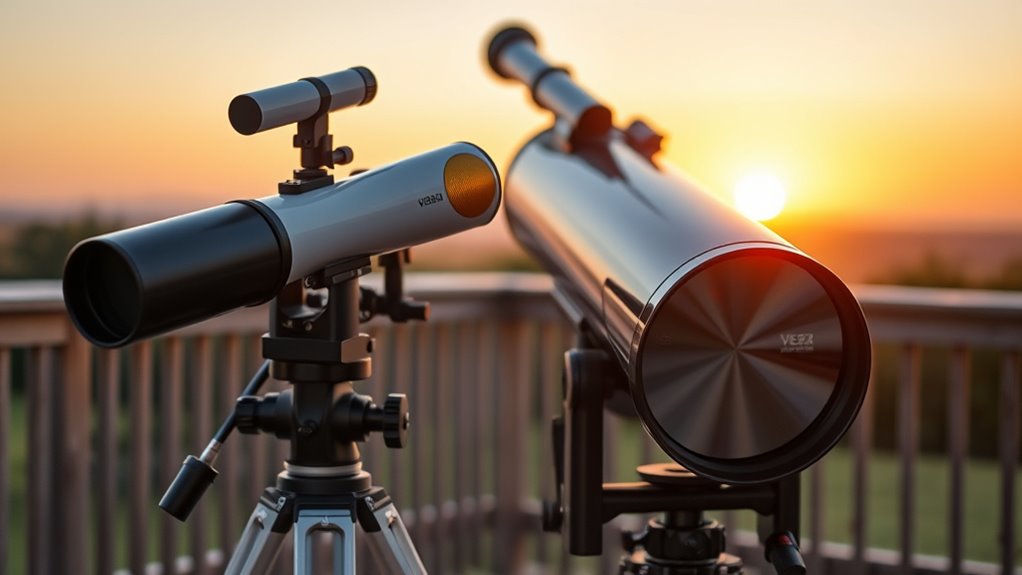
When choosing between a refractor and a reflector, size and weight play a big role in how you’ll use and transport your telescope. Refractors tend to be more compact and easier to carry, while reflectors can be bulkier and heavier. Consider how you’ll move your scope to different viewing spots to find the best fit for your needs. Additionally, understanding angel number soulmate can help you recognize signs of upcoming love opportunities, much like choosing the right telescope for your stargazing adventures.
Size and Dimensions
Have you ever considered how the size and weight of a telescope impact your observing experience? Your aperture size directly influences the overall dimensions, with larger apertures resulting in bigger, heavier telescopes. Reflectors tend to be bulkier because their mirrors require more space, while refractors usually have a more compact tube. Dimension considerations also include the length of the telescope, which affects setup and storage. If you prefer a lightweight, space-saving option, a smaller refractor might suit you better. Conversely, if you’re after higher magnification and light-gathering power, be prepared for a larger, more substantial instrument. Always think about how the size and dimensions align with your available space and how easy it will be to handle and set up your telescope.
Transportability and Carrying
The size and weight of a telescope play a significant role in how easily you can transport and set it up for observing sessions. Refractors tend to be more portable because they’re generally compact and lightweight, easing transportability challenges. Reflectors, especially larger models, can be bulky and heavy, making them harder to carry and requiring more effort to move. Portability considerations are important if you plan to observe at different locations or travel frequently. Smaller refractors fit easily into car trunks or backpacks, while larger reflectors may need special cases or carts. If you value quick setup and easy transportation, a refractor might be your best choice. However, for those willing to manage the weight, reflectors can offer larger apertures without sacrificing too much transportability. Additionally, building codes and zoning regulations can influence what equipment and setups are feasible in different locations.
Best Uses: Planets, Moon, or Deep Sky
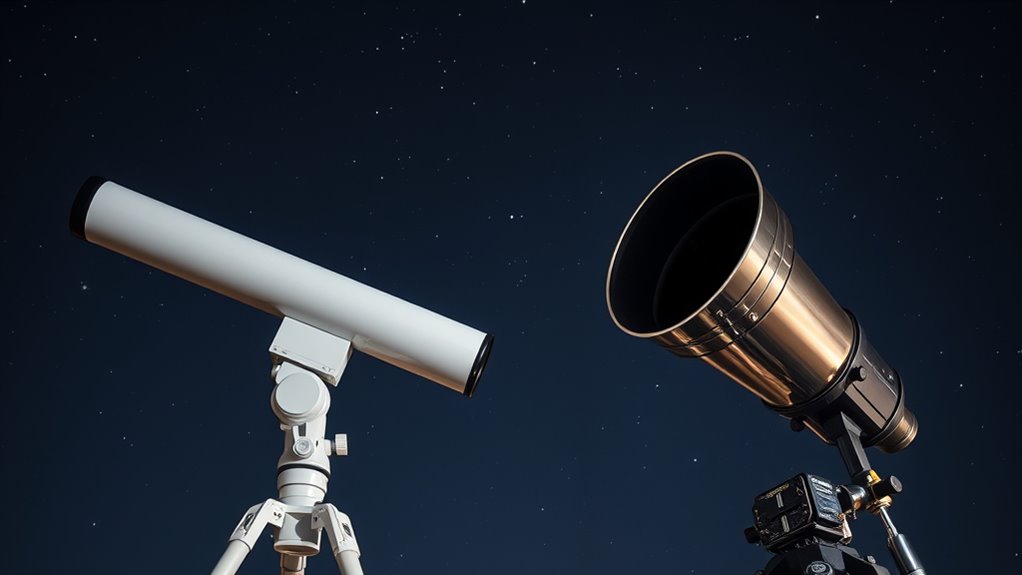
Are you wondering which type of telescope suits planetary, lunar, or deep-sky viewing? Your choice depends on aperture size and optical design. Refractors excel with bright, high-contrast images of planets and the Moon, thanks to their sharp, crisp optics. Their sealed optical tube reduces image distortion, making them ideal for detailed lunar and planetary observations. Reflectors, on the other hand, offer larger aperture sizes at a lower cost, making them better suited for deep-sky objects like galaxies and nebulae. Their optical design allows for wide fields of view, perfect for capturing expansive star clouds. For planetary and lunar viewing, a smaller, high-quality refractor may be best, while a larger reflector provides the power needed for deep-sky exploration.
Longevity and Investment Value

When considering longevity and investment value, refractors often stand out due to their durable, sealed optical tubes that resist dust and moisture, meaning they can last for decades with minimal maintenance. Their optical design, which uses lenses, ensures stable alignment over time, preserving image quality. This stability makes refractors a reliable choice for long-term use. Additionally, their sturdy construction often means fewer parts need replacing or repairing, protecting your investment. In terms of light collection, high-quality refractors provide consistent, sharp images without significant degradation. While they may initially cost more, their durability and ability to maintain ideal performance over many years make them a smart, lasting investment for beginners seeking dependable, long-term astronomy gear.
Common Challenges and Troubleshooting

While refractors are known for their durability and reliable performance over time, they can still present specific challenges that require troubleshooting. One common issue is alignment problems, which can cause blurry or distorted images. To fix this, you need to carefully check and adjust the optical tube’s alignment, ensuring the lenses are properly centered and secured. Another challenge involves optical coatings; over time, coatings can degrade or get scratched, reducing image clarity and brightness. If you notice a decline in image quality, inspect the lenses and consider cleaning or re-coating them professionally. Regular maintenance, gentle cleaning, and proper storage help prevent these issues. Addressing alignment issues and protecting optical coatings keep your refractor performing efficiently and extend its lifespan.
Which One Is Right for You?

Deciding between a refractor and a reflector telescope depends on your specific observing goals, budget, and experience level. If you want easy setup and crisp images for planetary viewing, a refractor might suit you. If you’re interested in deep-sky objects and budget-friendly options, a reflector could be better. Consider how you’ll use telescope accessories like filters or mounts, which vary between models. Additionally, using astronomical apps can help you identify objects and plan your sessions, regardless of your choice. Think about portability if you’ll travel often. Your comfort with maintenance and troubleshooting also matters—refractors generally require less upkeep. Ultimately, your decision hinges on what excites you most about astronomy and how much you’re willing to invest upfront.
Frequently Asked Questions
Which Telescope Type Offers Better Performance in Light-Polluted Areas?
In light-polluted areas, refractors generally offer better performance because their optical clarity isn’t as affected by stray light. They produce sharper images with less distortion from light pollution, making it easier for you to see planets and brighter objects. Reflectors, on the other hand, can struggle with optical issues like glare and image contrast. So, if you’re in an area with lots of light pollution, a refractor is your best bet for clear, crisp views.
Can Refractors or Reflectors Be Combined With Astrophotography Equipment?
Ever wondered if you can connect your telescope to astrophotography gear? Yes, you can! Refractors and reflectors both work with various lens accessories and mount compatibility, making them suitable for astrophotography. Refractors often excel with camera attachments due to their stable, sharp images, while reflectors can handle larger setups. Just verify your mount supports your chosen telescope, and you’ll be ready to capture stunning celestial images.
How Do Maintenance Costs Compare Over the Telescope’s Lifespan?
You’ll find that refractors generally have lower maintenance costs over their lifespan because they require less frequent repairs and are more durable. Reflectors, on the other hand, tend to need more repairs and cleaning due to their open design and mirror alignment issues. The cost comparison shows that while initial prices might differ, reflectors could incur higher repair frequency costs over time, making refractors more budget-friendly long-term.
Are There Specific Models Recommended for Absolute Beginners?
You’ll love the mountain models and beginner packages designed just for newcomers, making stargazing feel like an adventure of a lifetime! These models are straightforward, durable, and come with easy-to-use features that won’t leave you feeling lost in space. Choose a reputable brand offering beginner packages that include everything you need. With these, you’ll be exploring planets and stars in no time, turning amateur nights into cosmic journeys!
How Does the Initial Learning Curve Differ Between the Two Types?
You’ll find refractors easier to learn because they have less alignment difficulty and simpler assembly. Reflectors often require more time adjusting the mirrors and understanding the setup process, which can be challenging for beginners. Refractors generally come pre-assembled or with straightforward instructions, making the initial learning curve gentler. If you’re new to astronomy, a refractor helps you get started quickly without the frustration of complex assembly or frequent alignment.
Conclusion
So, whether you’re dazzled by the crisp, planet-popping images of a refractor or tempted by the budget-friendly, deep-sky capabilities of a reflector, remember: choosing a telescope is like choosing a life partner—full of compromises and unexpected quirks. Whichever you pick, just be prepared for a lifelong romance with occasional cosmic frustrations. After all, nothing says “stellar investment” quite like battling dust and blurry moons in pursuit of the perfect stargazing moment.
